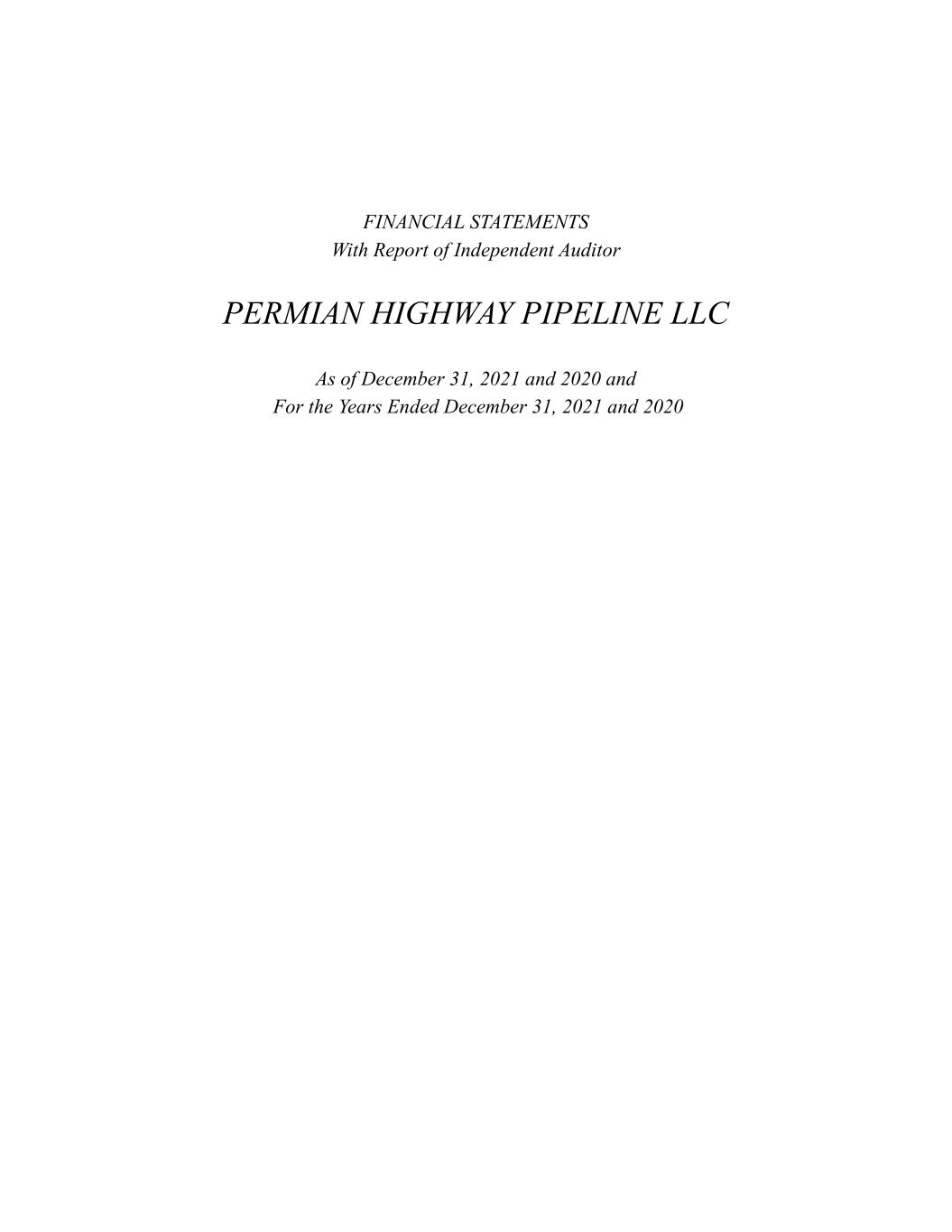
FINANCIAL STATEMENTS With Report of Independent Auditor PERMIAN HIGHWAY PIPELINE LLC As of December 31, 2021 and 2020 and For the Years Ended December 31, 2021 and 2020
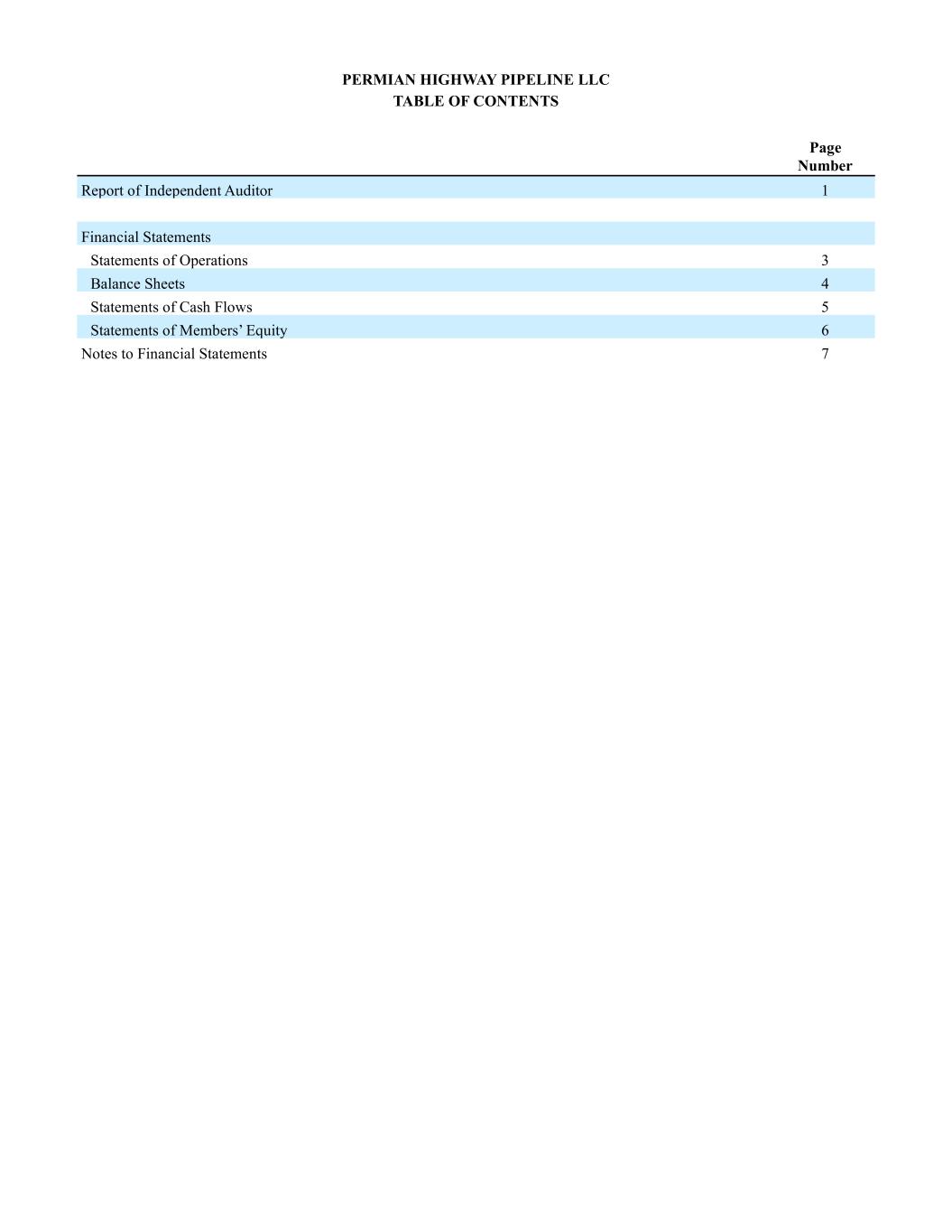
PERMIAN HIGHWAY PIPELINE LLC TABLE OF CONTENTS Page Number Report of Independent Auditor 1 Financial Statements Statements of Operations 3 Balance Sheets 4 Statements of Cash Flows 5 Statements of Members’ Equity 6 Notes to Financial Statements 7
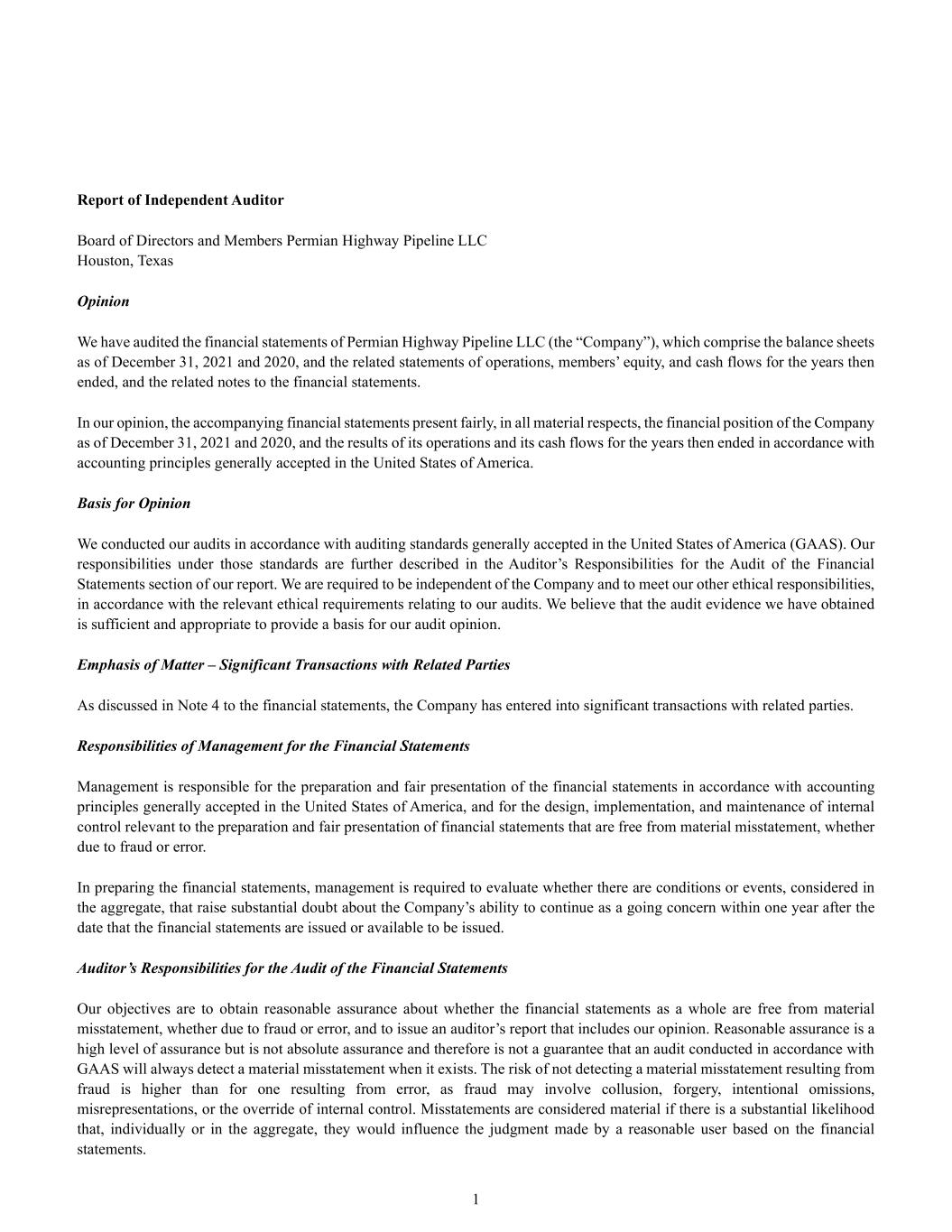
1 Report of Independent Auditor Board of Directors and Members Permian Highway Pipeline LLC Houston, Texas Opinion We have audited the financial statements of Permian Highway Pipeline LLC (the “Company”), which comprise the balance sheets as of December 31, 2021 and 2020, and the related statements of operations, members’ equity, and cash flows for the years then ended, and the related notes to the financial statements. In our opinion, the accompanying financial statements present fairly, in all material respects, the financial position of the Company as of December 31, 2021 and 2020, and the results of its operations and its cash flows for the years then ended in accordance with accounting principles generally accepted in the United States of America. Basis for Opinion We conducted our audits in accordance with auditing standards generally accepted in the United States of America (GAAS). Our responsibilities under those standards are further described in the Auditor’s Responsibilities for the Audit of the Financial Statements section of our report. We are required to be independent of the Company and to meet our other ethical responsibilities, in accordance with the relevant ethical requirements relating to our audits. We believe that the audit evidence we have obtained is sufficient and appropriate to provide a basis for our audit opinion. Emphasis of Matter – Significant Transactions with Related Parties As discussed in Note 4 to the financial statements, the Company has entered into significant transactions with related parties. Responsibilities of Management for the Financial Statements Management is responsible for the preparation and fair presentation of the financial statements in accordance with accounting principles generally accepted in the United States of America, and for the design, implementation, and maintenance of internal control relevant to the preparation and fair presentation of financial statements that are free from material misstatement, whether due to fraud or error. In preparing the financial statements, management is required to evaluate whether there are conditions or events, considered in the aggregate, that raise substantial doubt about the Company’s ability to continue as a going concern within one year after the date that the financial statements are issued or available to be issued. Auditor’s Responsibilities for the Audit of the Financial Statements Our objectives are to obtain reasonable assurance about whether the financial statements as a whole are free from material misstatement, whether due to fraud or error, and to issue an auditor’s report that includes our opinion. Reasonable assurance is a high level of assurance but is not absolute assurance and therefore is not a guarantee that an audit conducted in accordance with GAAS will always detect a material misstatement when it exists. The risk of not detecting a material misstatement resulting from fraud is higher than for one resulting from error, as fraud may involve collusion, forgery, intentional omissions, misrepresentations, or the override of internal control. Misstatements are considered material if there is a substantial likelihood that, individually or in the aggregate, they would influence the judgment made by a reasonable user based on the financial statements.
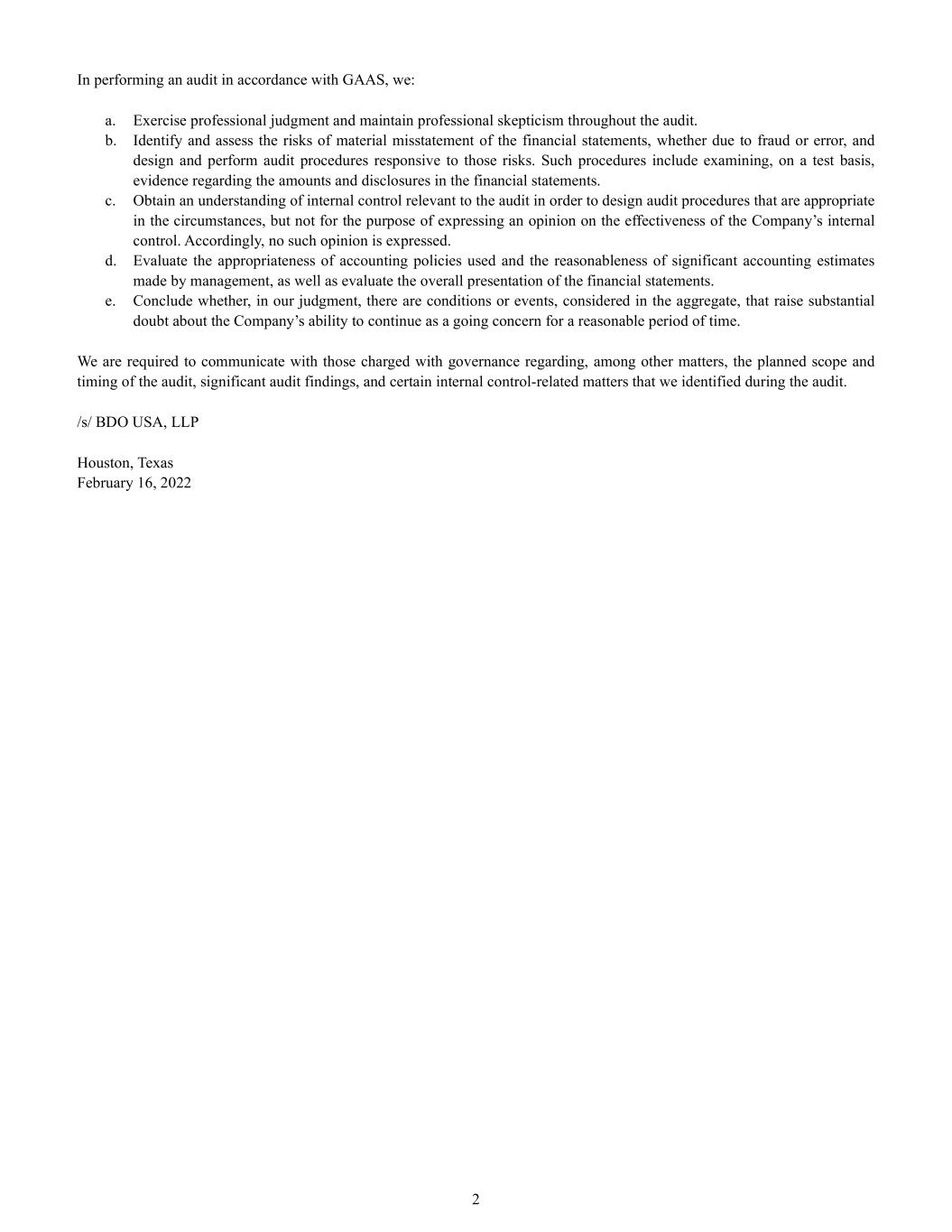
2 In performing an audit in accordance with GAAS, we: a. Exercise professional judgment and maintain professional skepticism throughout the audit. b. Identify and assess the risks of material misstatement of the financial statements, whether due to fraud or error, and design and perform audit procedures responsive to those risks. Such procedures include examining, on a test basis, evidence regarding the amounts and disclosures in the financial statements. c. Obtain an understanding of internal control relevant to the audit in order to design audit procedures that are appropriate in the circumstances, but not for the purpose of expressing an opinion on the effectiveness of the Company’s internal control. Accordingly, no such opinion is expressed. d. Evaluate the appropriateness of accounting policies used and the reasonableness of significant accounting estimates made by management, as well as evaluate the overall presentation of the financial statements. e. Conclude whether, in our judgment, there are conditions or events, considered in the aggregate, that raise substantial doubt about the Company’s ability to continue as a going concern for a reasonable period of time. We are required to communicate with those charged with governance regarding, among other matters, the planned scope and timing of the audit, significant audit findings, and certain internal control-related matters that we identified during the audit. /s/ BDO USA, LLP Houston, Texas February 16, 2022
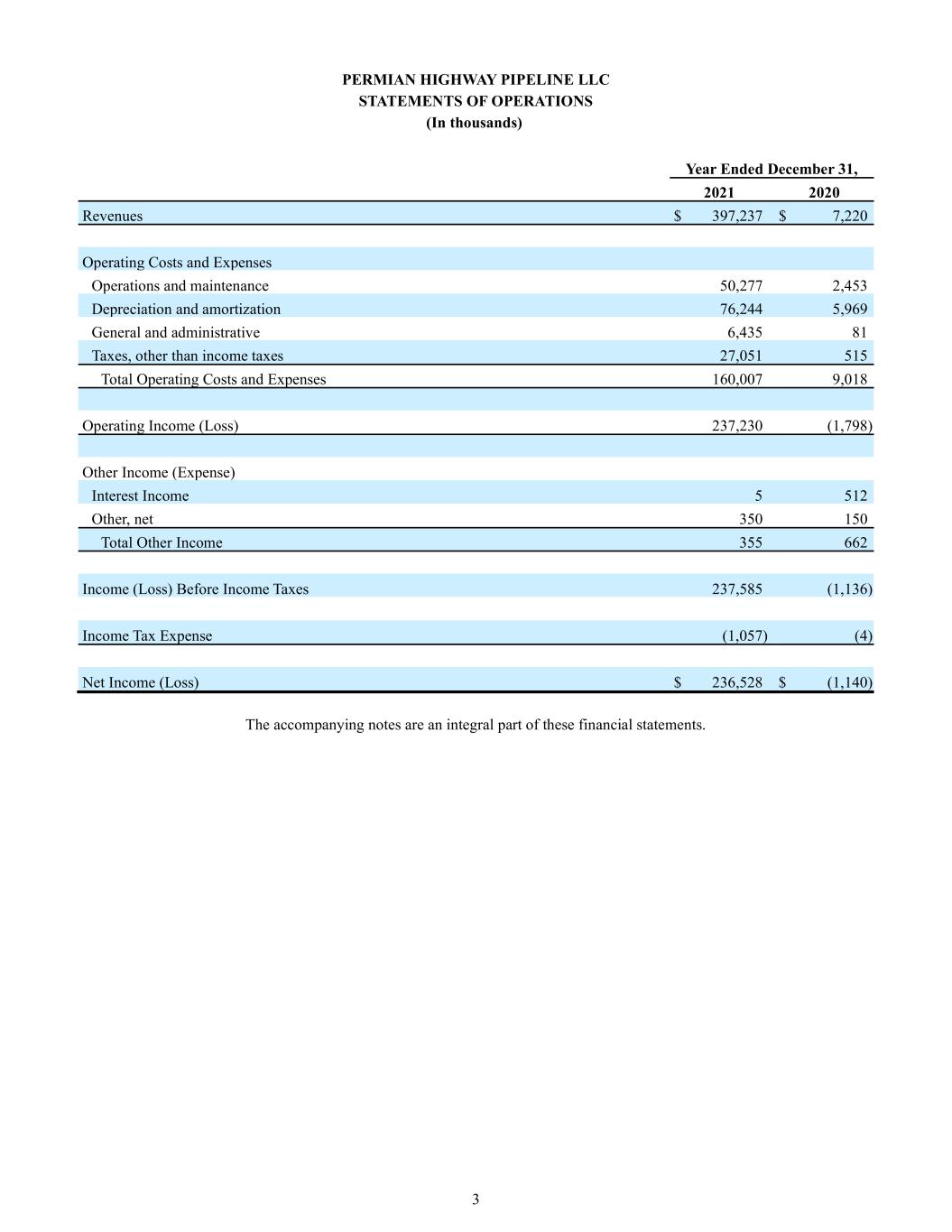
3 PERMIAN HIGHWAY PIPELINE LLC STATEMENTS OF OPERATIONS (In thousands) Year Ended December 31, 2021 2020 Revenues $ 397,237 $ 7,220 Operating Costs and Expenses Operations and maintenance 50,277 2,453 Depreciation and amortization 76,244 5,969 General and administrative 6,435 81 Taxes, other than income taxes 27,051 515 Total Operating Costs and Expenses 160,007 9,018 Operating Income (Loss) 237,230 (1,798) Other Income (Expense) Interest Income 5 512 Other, net 350 150 Total Other Income 355 662 Income (Loss) Before Income Taxes 237,585 (1,136) Income Tax Expense (1,057) (4) Net Income (Loss) $ 236,528 $ (1,140) The accompanying notes are an integral part of these financial statements.
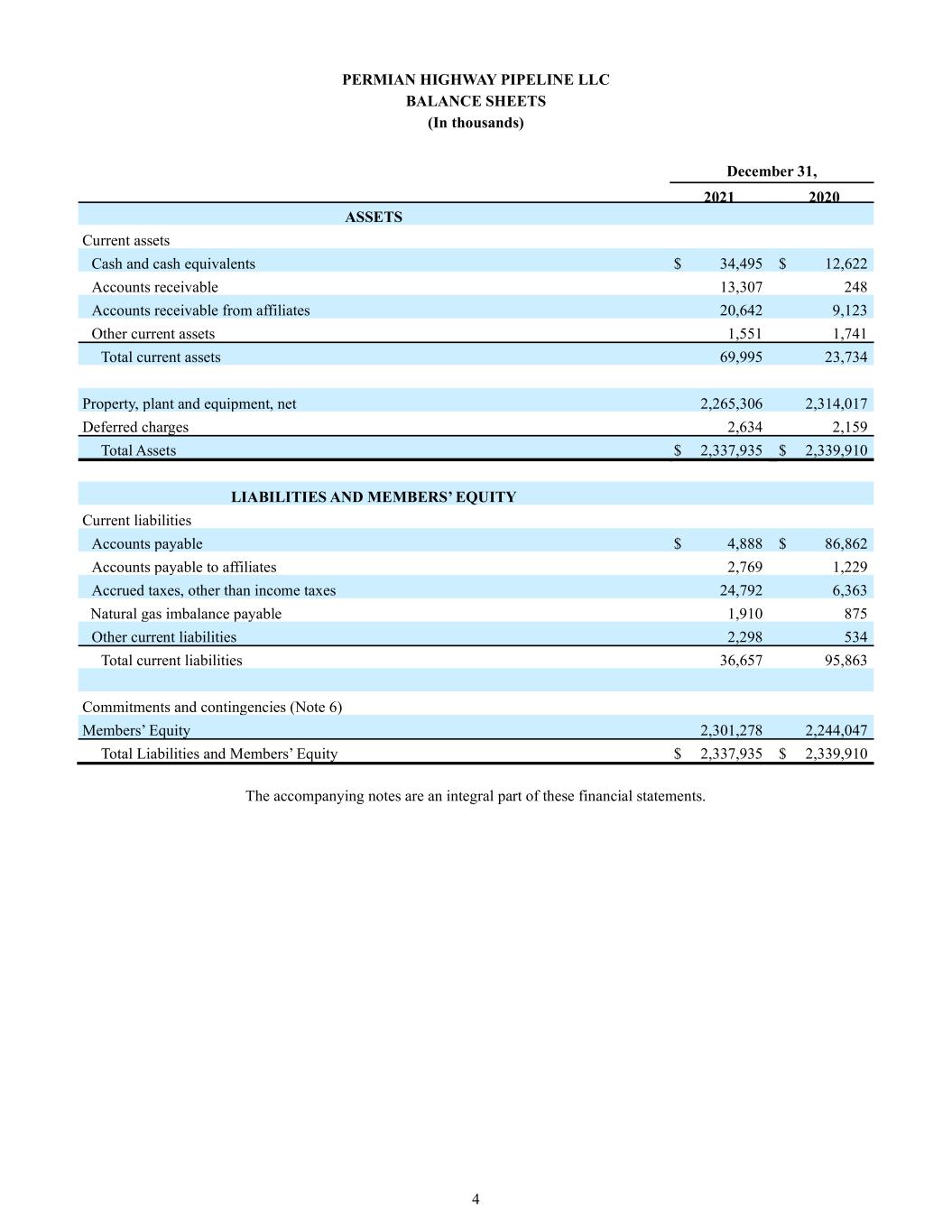
4 PERMIAN HIGHWAY PIPELINE LLC BALANCE SHEETS (In thousands) December 31, 2021 2020 ASSETS Current assets Cash and cash equivalents $ 34,495 $ 12,622 Accounts receivable 13,307 248 Accounts receivable from affiliates 20,642 9,123 Other current assets 1,551 1,741 Total current assets 69,995 23,734 Property, plant and equipment, net 2,265,306 2,314,017 Deferred charges 2,634 2,159 Total Assets $ 2,337,935 $ 2,339,910 LIABILITIES AND MEMBERS’ EQUITY Current liabilities Accounts payable $ 4,888 $ 86,862 Accounts payable to affiliates 2,769 1,229 Accrued taxes, other than income taxes 24,792 6,363 Natural gas imbalance payable 1,910 875 Other current liabilities 2,298 534 Total current liabilities 36,657 95,863 Commitments and contingencies (Note 6) Members’ Equity 2,301,278 2,244,047 Total Liabilities and Members’ Equity $ 2,337,935 $ 2,339,910 The accompanying notes are an integral part of these financial statements.
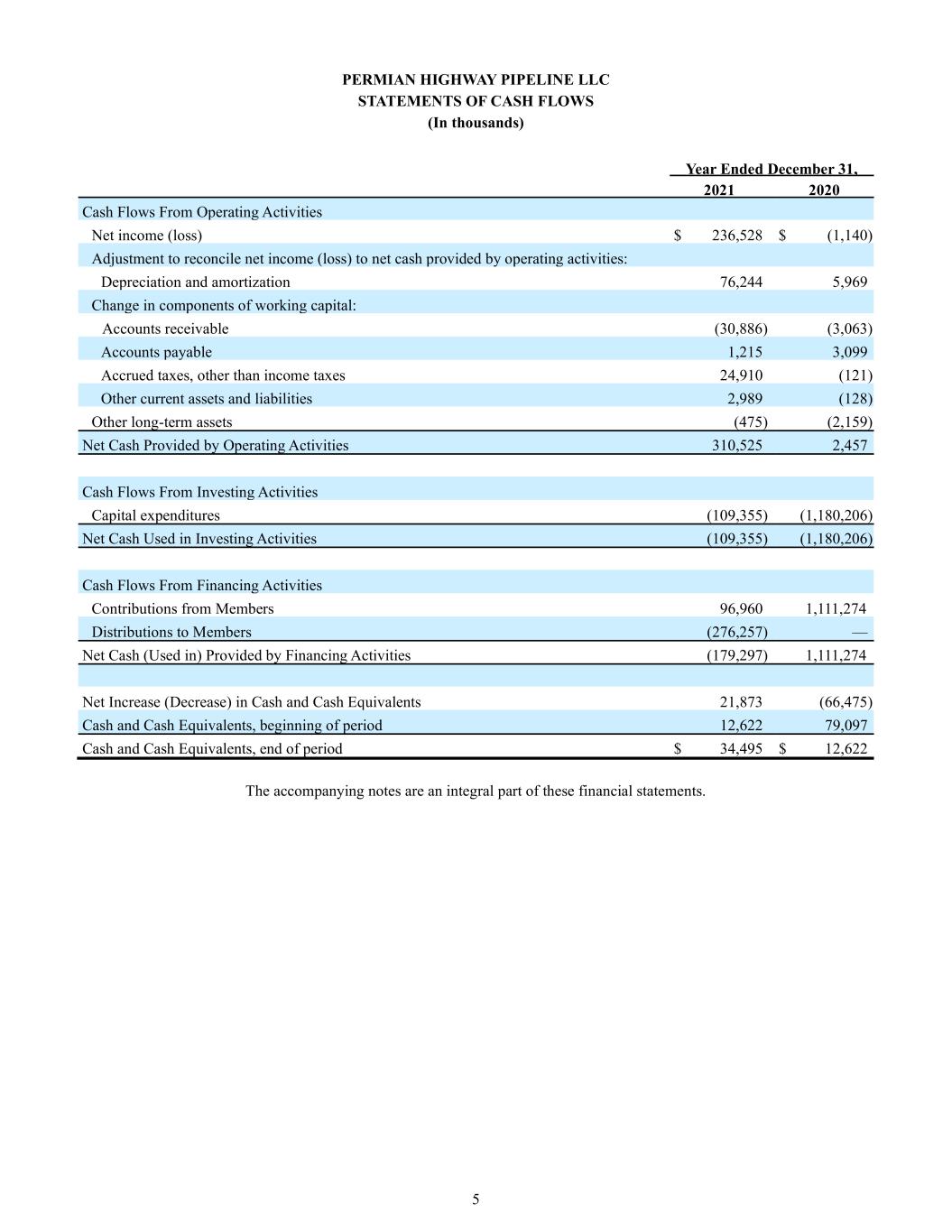
5 PERMIAN HIGHWAY PIPELINE LLC STATEMENTS OF CASH FLOWS (In thousands) Year Ended December 31, 2021 2020 Cash Flows From Operating Activities Net income (loss) $ 236,528 $ (1,140) Adjustment to reconcile net income (loss) to net cash provided by operating activities: Depreciation and amortization 76,244 5,969 Change in components of working capital: Accounts receivable (30,886) (3,063) Accounts payable 1,215 3,099 Accrued taxes, other than income taxes 24,910 (121) Other current assets and liabilities 2,989 (128) Other long-term assets (475) (2,159) Net Cash Provided by Operating Activities 310,525 2,457 Cash Flows From Investing Activities Capital expenditures (109,355) (1,180,206) Net Cash Used in Investing Activities (109,355) (1,180,206) Cash Flows From Financing Activities Contributions from Members 96,960 1,111,274 Distributions to Members (276,257) — Net Cash (Used in) Provided by Financing Activities (179,297) 1,111,274 Net Increase (Decrease) in Cash and Cash Equivalents 21,873 (66,475) Cash and Cash Equivalents, beginning of period 12,622 79,097 Cash and Cash Equivalents, end of period $ 34,495 $ 12,622 The accompanying notes are an integral part of these financial statements.
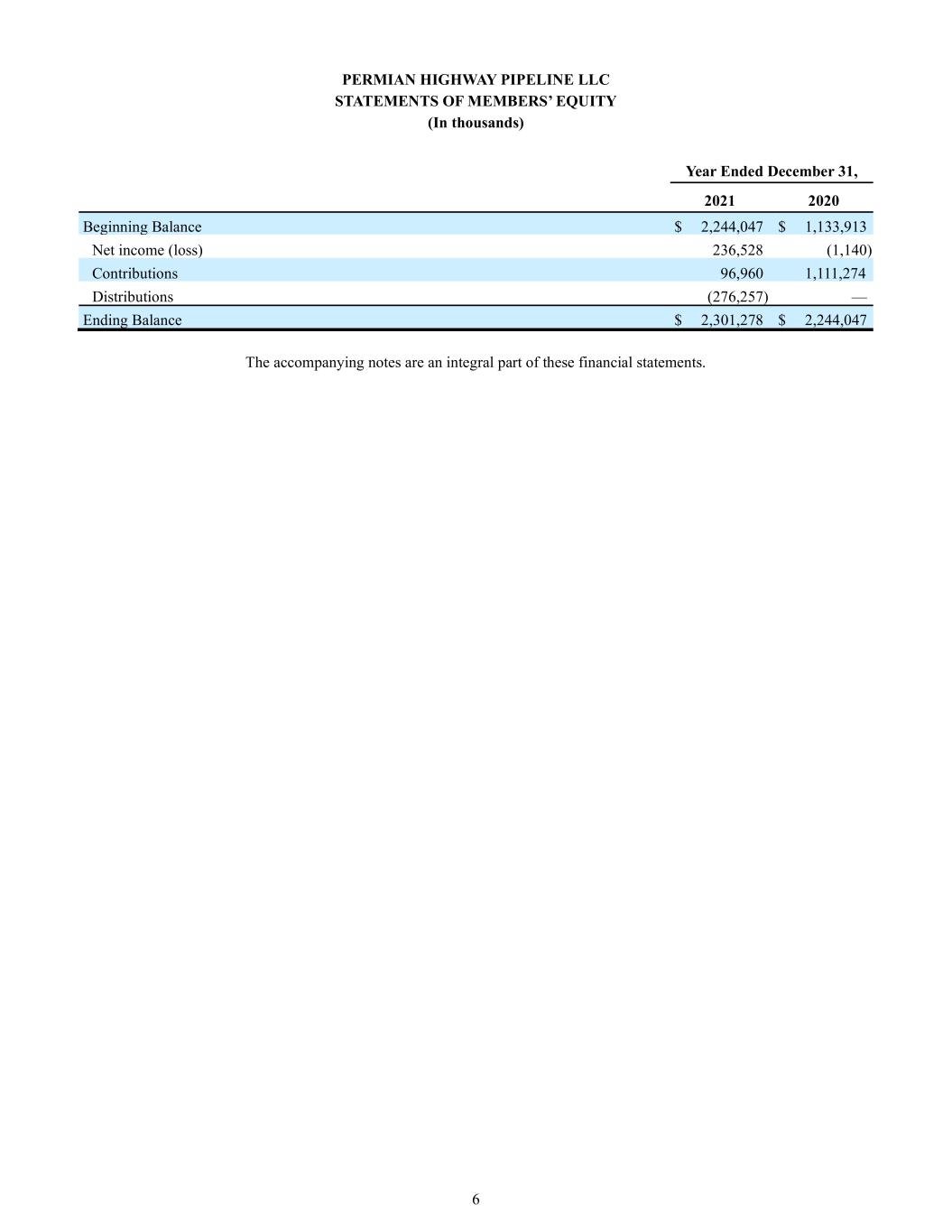
6 PERMIAN HIGHWAY PIPELINE LLC STATEMENTS OF MEMBERS’ EQUITY (In thousands) Year Ended December 31, 2021 2020 Beginning Balance $ 2,244,047 $ 1,133,913 Net income (loss) 236,528 (1,140) Contributions 96,960 1,111,274 Distributions (276,257) — Ending Balance $ 2,301,278 $ 2,244,047 The accompanying notes are an integral part of these financial statements.
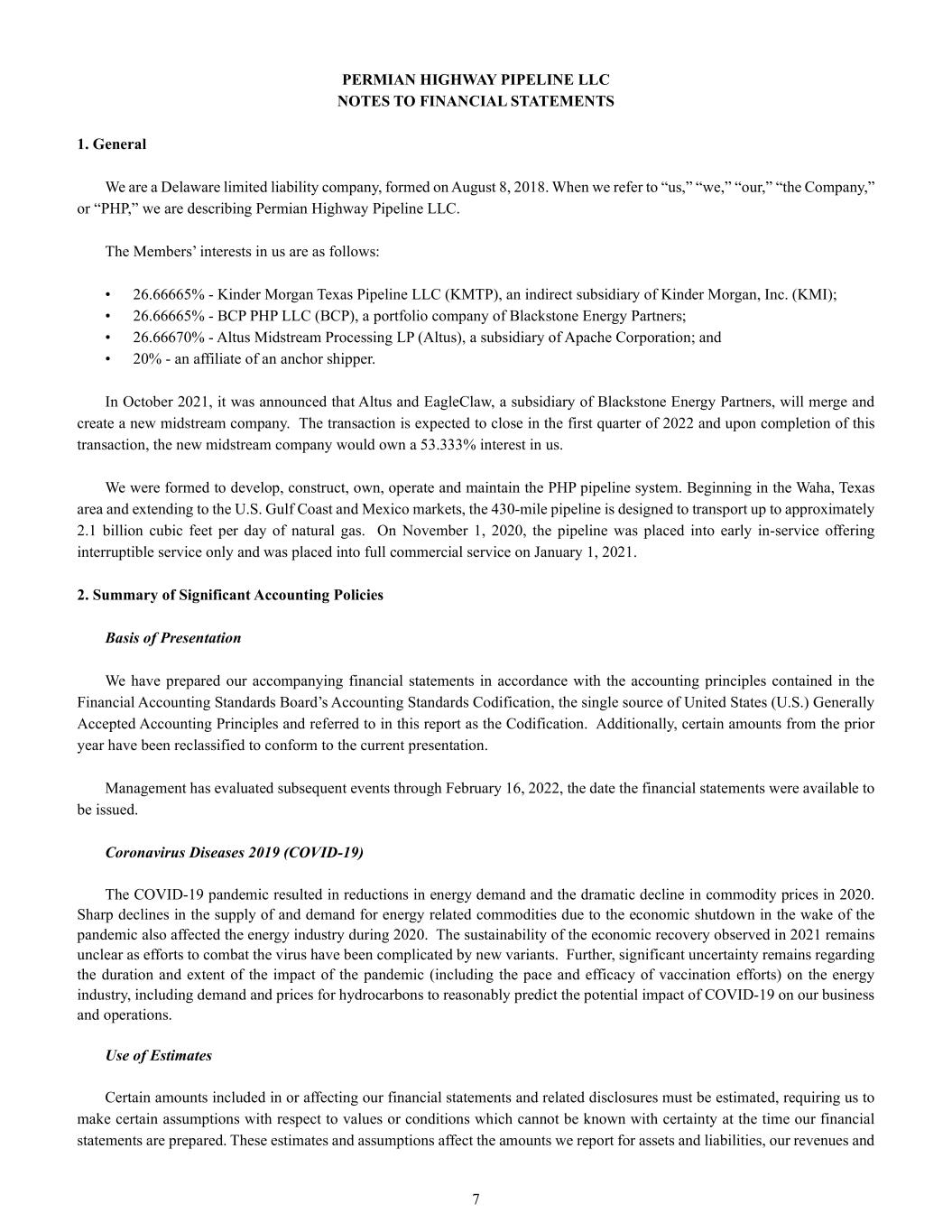
7 PERMIAN HIGHWAY PIPELINE LLC NOTES TO FINANCIAL STATEMENTS 1. General We are a Delaware limited liability company, formed on August 8, 2018. When we refer to “us,” “we,” “our,” “the Company,” or “PHP,” we are describing Permian Highway Pipeline LLC. The Members’ interests in us are as follows: • 26.66665% - Kinder Morgan Texas Pipeline LLC (KMTP), an indirect subsidiary of Kinder Morgan, Inc. (KMI); • 26.66665% - BCP PHP LLC (BCP), a portfolio company of Blackstone Energy Partners; • 26.66670% - Altus Midstream Processing LP (Altus), a subsidiary of Apache Corporation; and • 20% - an affiliate of an anchor shipper. In October 2021, it was announced that Altus and EagleClaw, a subsidiary of Blackstone Energy Partners, will merge and create a new midstream company. The transaction is expected to close in the first quarter of 2022 and upon completion of this transaction, the new midstream company would own a 53.333% interest in us. We were formed to develop, construct, own, operate and maintain the PHP pipeline system. Beginning in the Waha, Texas area and extending to the U.S. Gulf Coast and Mexico markets, the 430-mile pipeline is designed to transport up to approximately 2.1 billion cubic feet per day of natural gas. On November 1, 2020, the pipeline was placed into early in-service offering interruptible service only and was placed into full commercial service on January 1, 2021. 2. Summary of Significant Accounting Policies Basis of Presentation We have prepared our accompanying financial statements in accordance with the accounting principles contained in the Financial Accounting Standards Board’s Accounting Standards Codification, the single source of United States (U.S.) Generally Accepted Accounting Principles and referred to in this report as the Codification. Additionally, certain amounts from the prior year have been reclassified to conform to the current presentation. Management has evaluated subsequent events through February 16, 2022, the date the financial statements were available to be issued. Coronavirus Diseases 2019 (COVID-19) The COVID-19 pandemic resulted in reductions in energy demand and the dramatic decline in commodity prices in 2020. Sharp declines in the supply of and demand for energy related commodities due to the economic shutdown in the wake of the pandemic also affected the energy industry during 2020. The sustainability of the economic recovery observed in 2021 remains unclear as efforts to combat the virus have been complicated by new variants. Further, significant uncertainty remains regarding the duration and extent of the impact of the pandemic (including the pace and efficacy of vaccination efforts) on the energy industry, including demand and prices for hydrocarbons to reasonably predict the potential impact of COVID-19 on our business and operations. Use of Estimates Certain amounts included in or affecting our financial statements and related disclosures must be estimated, requiring us to make certain assumptions with respect to values or conditions which cannot be known with certainty at the time our financial statements are prepared. These estimates and assumptions affect the amounts we report for assets and liabilities, our revenues and
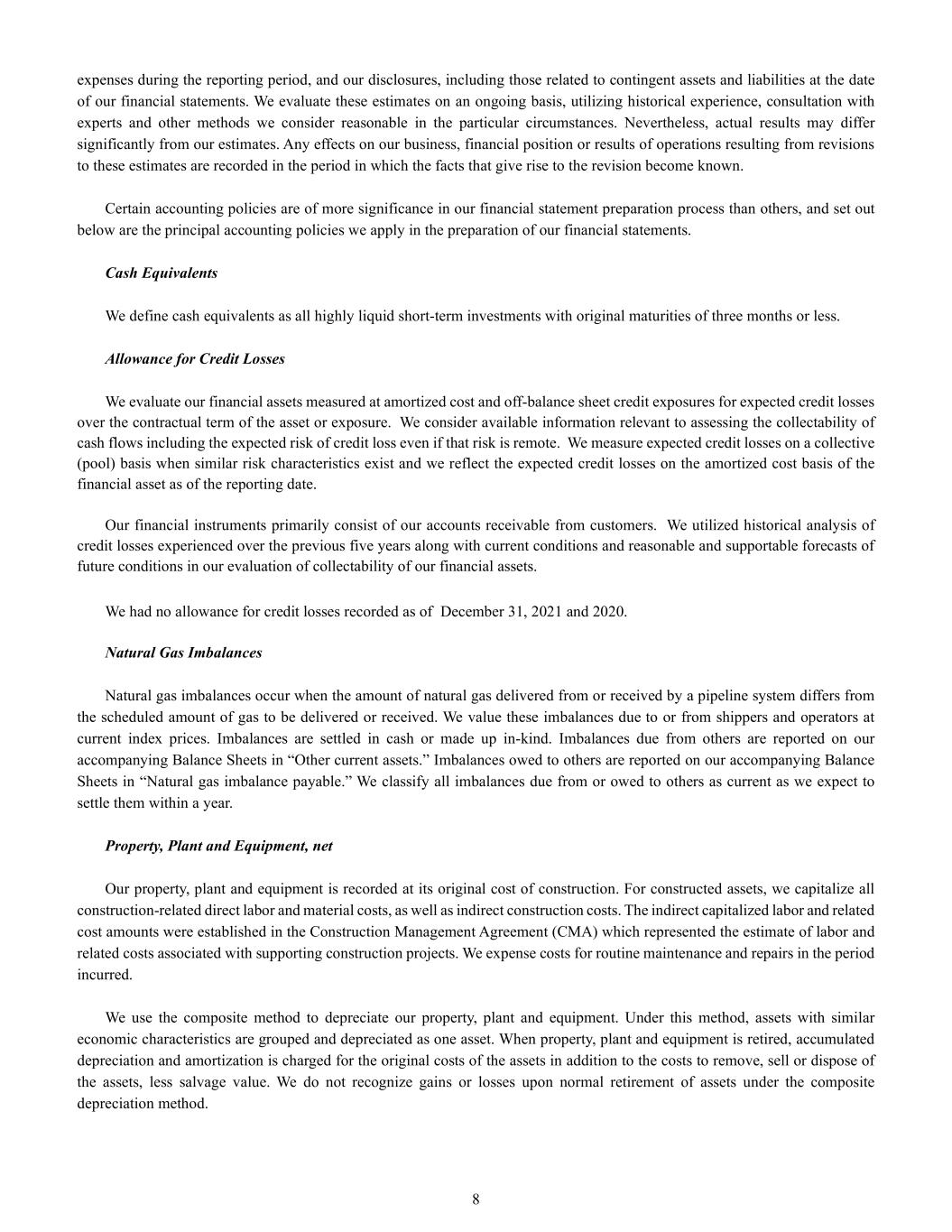
8 expenses during the reporting period, and our disclosures, including those related to contingent assets and liabilities at the date of our financial statements. We evaluate these estimates on an ongoing basis, utilizing historical experience, consultation with experts and other methods we consider reasonable in the particular circumstances. Nevertheless, actual results may differ significantly from our estimates. Any effects on our business, financial position or results of operations resulting from revisions to these estimates are recorded in the period in which the facts that give rise to the revision become known. Certain accounting policies are of more significance in our financial statement preparation process than others, and set out below are the principal accounting policies we apply in the preparation of our financial statements. Cash Equivalents We define cash equivalents as all highly liquid short-term investments with original maturities of three months or less. Allowance for Credit Losses We evaluate our financial assets measured at amortized cost and off-balance sheet credit exposures for expected credit losses over the contractual term of the asset or exposure. We consider available information relevant to assessing the collectability of cash flows including the expected risk of credit loss even if that risk is remote. We measure expected credit losses on a collective (pool) basis when similar risk characteristics exist and we reflect the expected credit losses on the amortized cost basis of the financial asset as of the reporting date. Our financial instruments primarily consist of our accounts receivable from customers. We utilized historical analysis of credit losses experienced over the previous five years along with current conditions and reasonable and supportable forecasts of future conditions in our evaluation of collectability of our financial assets. We had no allowance for credit losses recorded as of December 31, 2021 and 2020. Natural Gas Imbalances Natural gas imbalances occur when the amount of natural gas delivered from or received by a pipeline system differs from the scheduled amount of gas to be delivered or received. We value these imbalances due to or from shippers and operators at current index prices. Imbalances are settled in cash or made up in-kind. Imbalances due from others are reported on our accompanying Balance Sheets in “Other current assets.” Imbalances owed to others are reported on our accompanying Balance Sheets in “Natural gas imbalance payable.” We classify all imbalances due from or owed to others as current as we expect to settle them within a year. Property, Plant and Equipment, net Our property, plant and equipment is recorded at its original cost of construction. For constructed assets, we capitalize all construction-related direct labor and material costs, as well as indirect construction costs. The indirect capitalized labor and related cost amounts were established in the Construction Management Agreement (CMA) which represented the estimate of labor and related costs associated with supporting construction projects. We expense costs for routine maintenance and repairs in the period incurred. We use the composite method to depreciate our property, plant and equipment. Under this method, assets with similar economic characteristics are grouped and depreciated as one asset. When property, plant and equipment is retired, accumulated depreciation and amortization is charged for the original costs of the assets in addition to the costs to remove, sell or dispose of the assets, less salvage value. We do not recognize gains or losses upon normal retirement of assets under the composite depreciation method.
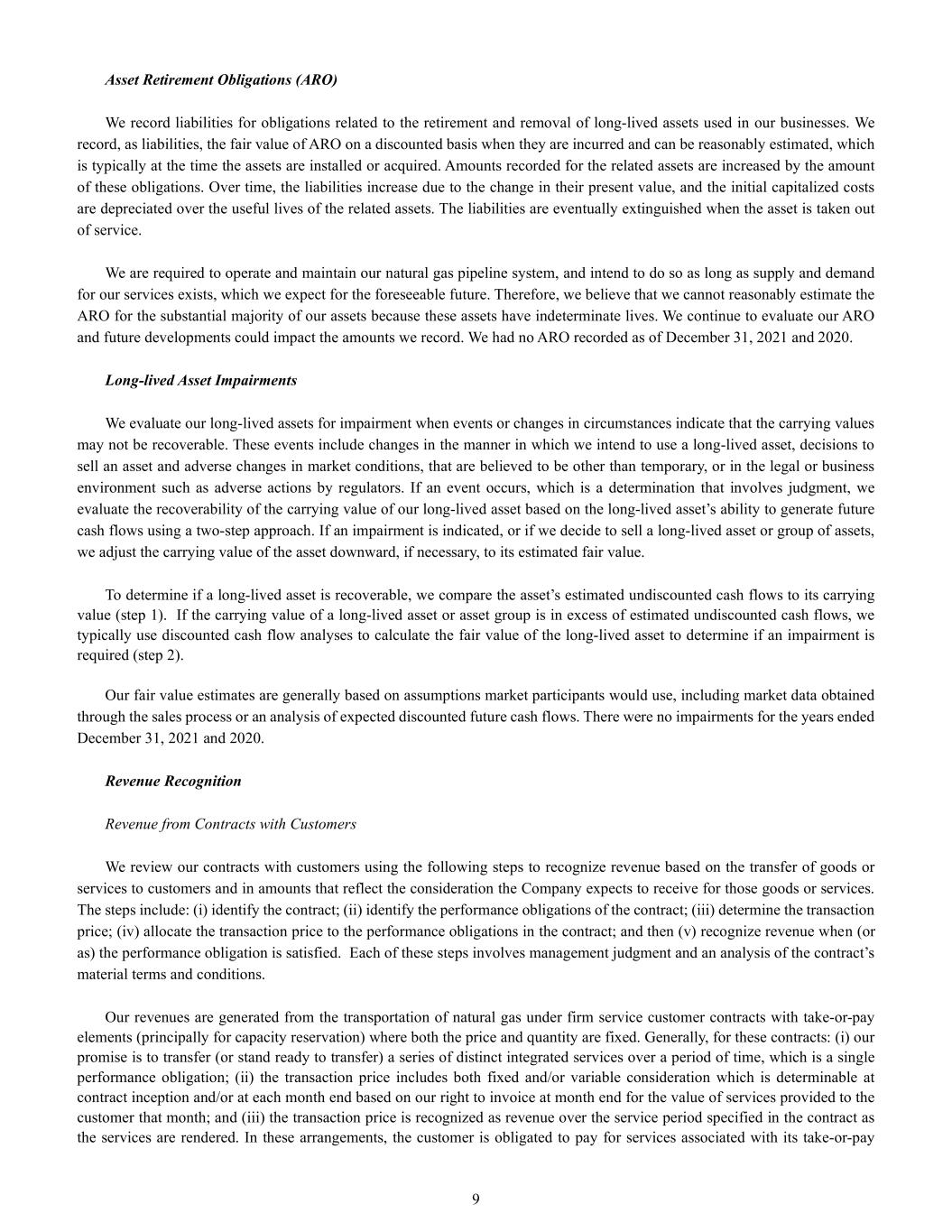
9 Asset Retirement Obligations (ARO) We record liabilities for obligations related to the retirement and removal of long-lived assets used in our businesses. We record, as liabilities, the fair value of ARO on a discounted basis when they are incurred and can be reasonably estimated, which is typically at the time the assets are installed or acquired. Amounts recorded for the related assets are increased by the amount of these obligations. Over time, the liabilities increase due to the change in their present value, and the initial capitalized costs are depreciated over the useful lives of the related assets. The liabilities are eventually extinguished when the asset is taken out of service. We are required to operate and maintain our natural gas pipeline system, and intend to do so as long as supply and demand for our services exists, which we expect for the foreseeable future. Therefore, we believe that we cannot reasonably estimate the ARO for the substantial majority of our assets because these assets have indeterminate lives. We continue to evaluate our ARO and future developments could impact the amounts we record. We had no ARO recorded as of December 31, 2021 and 2020. Long-lived Asset Impairments We evaluate our long-lived assets for impairment when events or changes in circumstances indicate that the carrying values may not be recoverable. These events include changes in the manner in which we intend to use a long-lived asset, decisions to sell an asset and adverse changes in market conditions, that are believed to be other than temporary, or in the legal or business environment such as adverse actions by regulators. If an event occurs, which is a determination that involves judgment, we evaluate the recoverability of the carrying value of our long-lived asset based on the long-lived asset’s ability to generate future cash flows using a two-step approach. If an impairment is indicated, or if we decide to sell a long-lived asset or group of assets, we adjust the carrying value of the asset downward, if necessary, to its estimated fair value. To determine if a long-lived asset is recoverable, we compare the asset’s estimated undiscounted cash flows to its carrying value (step 1). If the carrying value of a long-lived asset or asset group is in excess of estimated undiscounted cash flows, we typically use discounted cash flow analyses to calculate the fair value of the long-lived asset to determine if an impairment is required (step 2). Our fair value estimates are generally based on assumptions market participants would use, including market data obtained through the sales process or an analysis of expected discounted future cash flows. There were no impairments for the years ended December 31, 2021 and 2020. Revenue Recognition Revenue from Contracts with Customers We review our contracts with customers using the following steps to recognize revenue based on the transfer of goods or services to customers and in amounts that reflect the consideration the Company expects to receive for those goods or services. The steps include: (i) identify the contract; (ii) identify the performance obligations of the contract; (iii) determine the transaction price; (iv) allocate the transaction price to the performance obligations in the contract; and then (v) recognize revenue when (or as) the performance obligation is satisfied. Each of these steps involves management judgment and an analysis of the contract’s material terms and conditions. Our revenues are generated from the transportation of natural gas under firm service customer contracts with take-or-pay elements (principally for capacity reservation) where both the price and quantity are fixed. Generally, for these contracts: (i) our promise is to transfer (or stand ready to transfer) a series of distinct integrated services over a period of time, which is a single performance obligation; (ii) the transaction price includes both fixed and/or variable consideration which is determinable at contract inception and/or at each month end based on our right to invoice at month end for the value of services provided to the customer that month; and (iii) the transaction price is recognized as revenue over the service period specified in the contract as the services are rendered. In these arrangements, the customer is obligated to pay for services associated with its take-or-pay
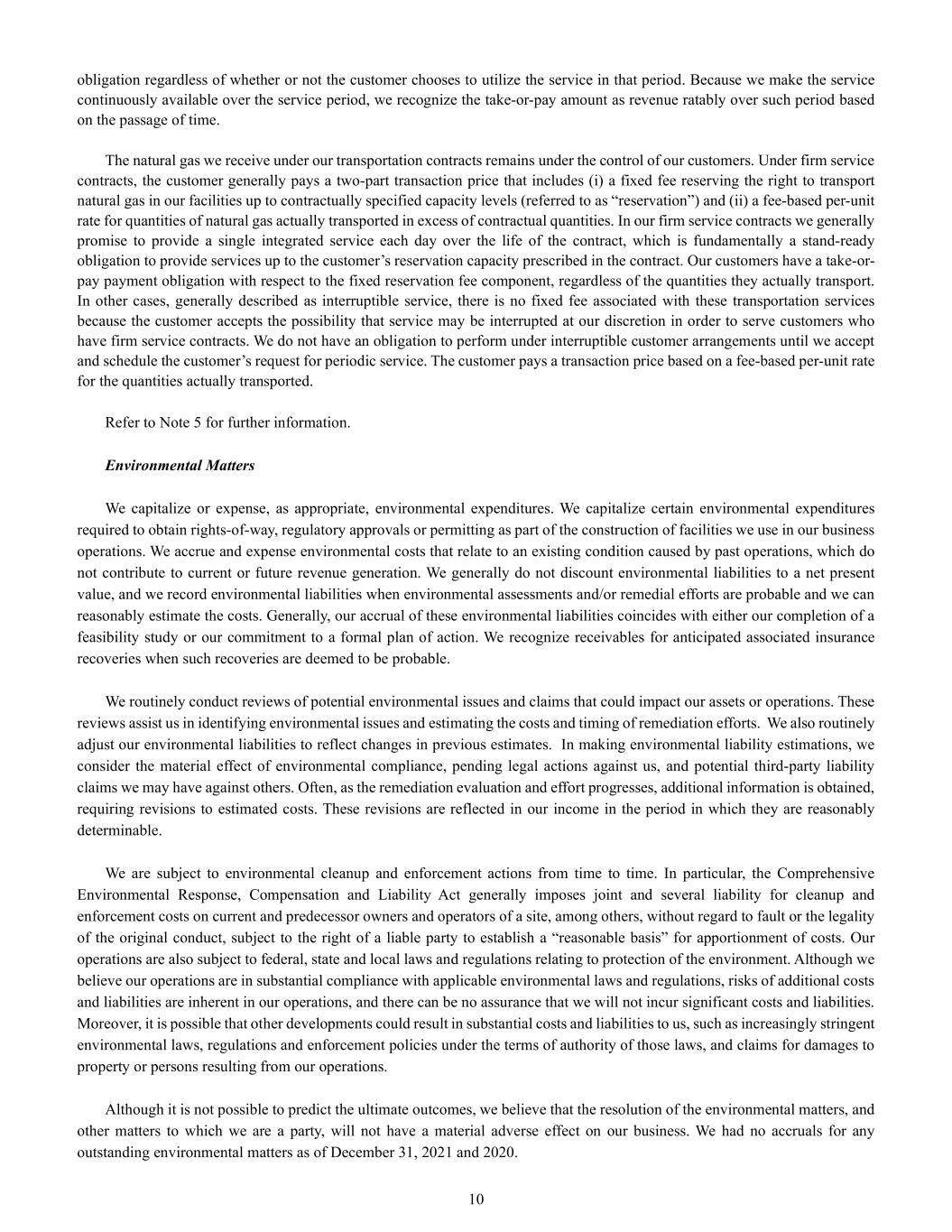
10 obligation regardless of whether or not the customer chooses to utilize the service in that period. Because we make the service continuously available over the service period, we recognize the take-or-pay amount as revenue ratably over such period based on the passage of time. The natural gas we receive under our transportation contracts remains under the control of our customers. Under firm service contracts, the customer generally pays a two-part transaction price that includes (i) a fixed fee reserving the right to transport natural gas in our facilities up to contractually specified capacity levels (referred to as “reservation”) and (ii) a fee-based per-unit rate for quantities of natural gas actually transported in excess of contractual quantities. In our firm service contracts we generally promise to provide a single integrated service each day over the life of the contract, which is fundamentally a stand-ready obligation to provide services up to the customer’s reservation capacity prescribed in the contract. Our customers have a take-or- pay payment obligation with respect to the fixed reservation fee component, regardless of the quantities they actually transport. In other cases, generally described as interruptible service, there is no fixed fee associated with these transportation services because the customer accepts the possibility that service may be interrupted at our discretion in order to serve customers who have firm service contracts. We do not have an obligation to perform under interruptible customer arrangements until we accept and schedule the customer’s request for periodic service. The customer pays a transaction price based on a fee-based per-unit rate for the quantities actually transported. Refer to Note 5 for further information. Environmental Matters We capitalize or expense, as appropriate, environmental expenditures. We capitalize certain environmental expenditures required to obtain rights-of-way, regulatory approvals or permitting as part of the construction of facilities we use in our business operations. We accrue and expense environmental costs that relate to an existing condition caused by past operations, which do not contribute to current or future revenue generation. We generally do not discount environmental liabilities to a net present value, and we record environmental liabilities when environmental assessments and/or remedial efforts are probable and we can reasonably estimate the costs. Generally, our accrual of these environmental liabilities coincides with either our completion of a feasibility study or our commitment to a formal plan of action. We recognize receivables for anticipated associated insurance recoveries when such recoveries are deemed to be probable. We routinely conduct reviews of potential environmental issues and claims that could impact our assets or operations. These reviews assist us in identifying environmental issues and estimating the costs and timing of remediation efforts. We also routinely adjust our environmental liabilities to reflect changes in previous estimates. In making environmental liability estimations, we consider the material effect of environmental compliance, pending legal actions against us, and potential third-party liability claims we may have against others. Often, as the remediation evaluation and effort progresses, additional information is obtained, requiring revisions to estimated costs. These revisions are reflected in our income in the period in which they are reasonably determinable. We are subject to environmental cleanup and enforcement actions from time to time. In particular, the Comprehensive Environmental Response, Compensation and Liability Act generally imposes joint and several liability for cleanup and enforcement costs on current and predecessor owners and operators of a site, among others, without regard to fault or the legality of the original conduct, subject to the right of a liable party to establish a “reasonable basis” for apportionment of costs. Our operations are also subject to federal, state and local laws and regulations relating to protection of the environment. Although we believe our operations are in substantial compliance with applicable environmental laws and regulations, risks of additional costs and liabilities are inherent in our operations, and there can be no assurance that we will not incur significant costs and liabilities. Moreover, it is possible that other developments could result in substantial costs and liabilities to us, such as increasingly stringent environmental laws, regulations and enforcement policies under the terms of authority of those laws, and claims for damages to property or persons resulting from our operations. Although it is not possible to predict the ultimate outcomes, we believe that the resolution of the environmental matters, and other matters to which we are a party, will not have a material adverse effect on our business. We had no accruals for any outstanding environmental matters as of December 31, 2021 and 2020.
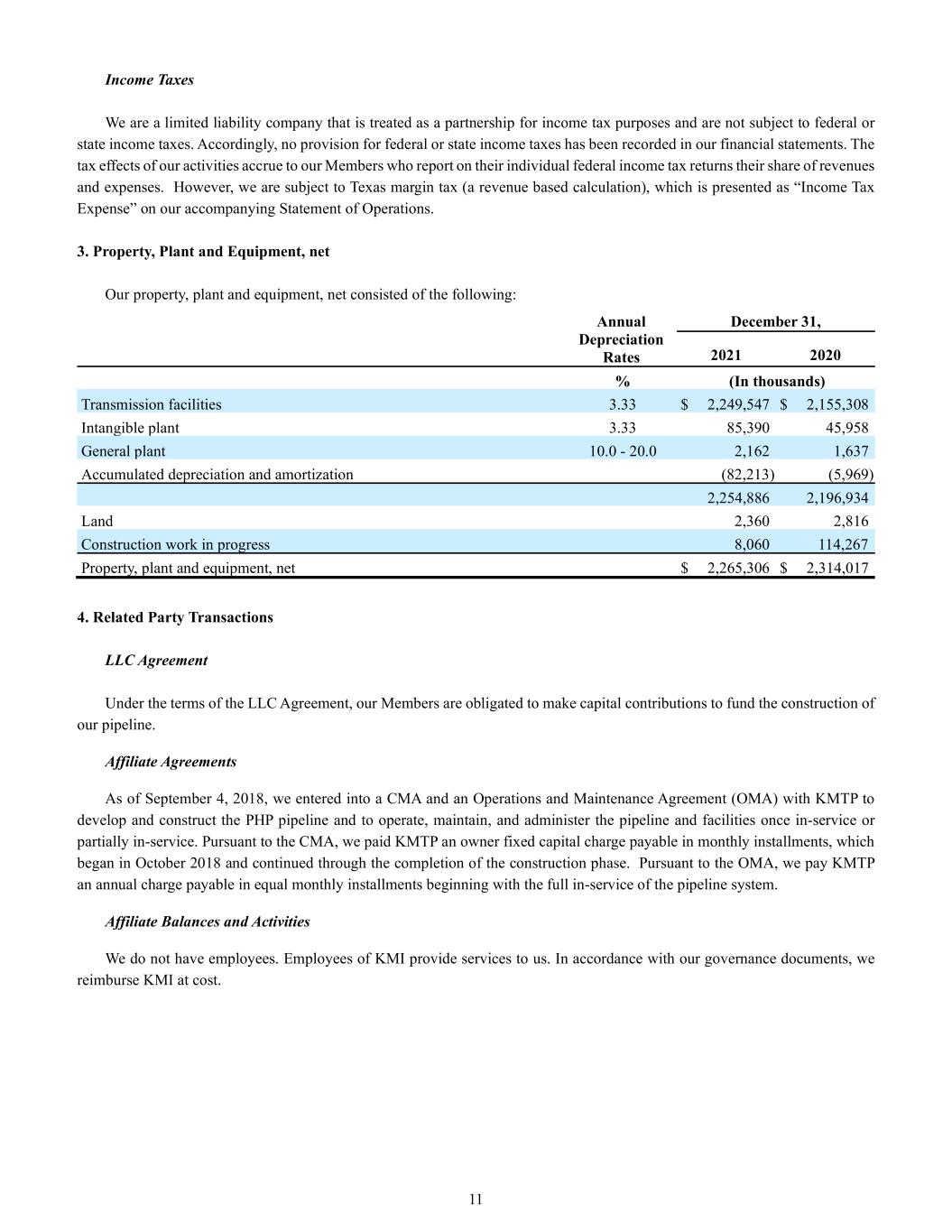
11 Income Taxes We are a limited liability company that is treated as a partnership for income tax purposes and are not subject to federal or state income taxes. Accordingly, no provision for federal or state income taxes has been recorded in our financial statements. The tax effects of our activities accrue to our Members who report on their individual federal income tax returns their share of revenues and expenses. However, we are subject to Texas margin tax (a revenue based calculation), which is presented as “Income Tax Expense” on our accompanying Statement of Operations. 3. Property, Plant and Equipment, net Our property, plant and equipment, net consisted of the following: Annual Depreciation Rates December 31, 2021 2020 % (In thousands) Transmission facilities 3.33 $ 2,249,547 $ 2,155,308 Intangible plant 3.33 85,390 45,958 General plant 10.0 - 20.0 2,162 1,637 Accumulated depreciation and amortization (82,213) (5,969) 2,254,886 2,196,934 Land 2,360 2,816 Construction work in progress 8,060 114,267 Property, plant and equipment, net $ 2,265,306 $ 2,314,017 4. Related Party Transactions LLC Agreement Under the terms of the LLC Agreement, our Members are obligated to make capital contributions to fund the construction of our pipeline. Affiliate Agreements As of September 4, 2018, we entered into a CMA and an Operations and Maintenance Agreement (OMA) with KMTP to develop and construct the PHP pipeline and to operate, maintain, and administer the pipeline and facilities once in-service or partially in-service. Pursuant to the CMA, we paid KMTP an owner fixed capital charge payable in monthly installments, which began in October 2018 and continued through the completion of the construction phase. Pursuant to the OMA, we pay KMTP an annual charge payable in equal monthly installments beginning with the full in-service of the pipeline system. Affiliate Balances and Activities We do not have employees. Employees of KMI provide services to us. In accordance with our governance documents, we reimburse KMI at cost.
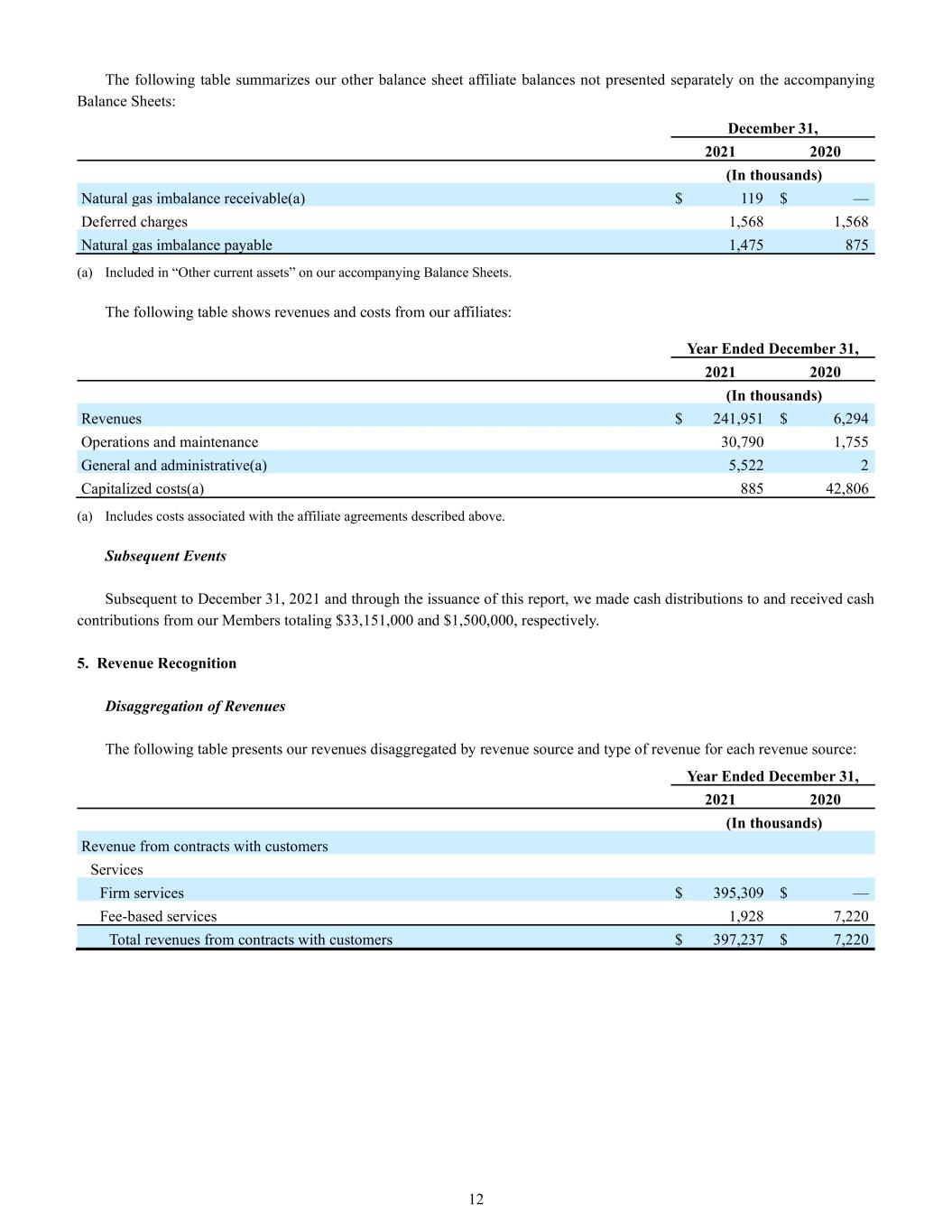
12 The following table summarizes our other balance sheet affiliate balances not presented separately on the accompanying Balance Sheets: December 31, 2021 2020 (In thousands) Natural gas imbalance receivable(a) $ 119 $ — Deferred charges 1,568 1,568 Natural gas imbalance payable 1,475 875 (a) Included in “Other current assets” on our accompanying Balance Sheets. The following table shows revenues and costs from our affiliates: Year Ended December 31, 2021 2020 (In thousands) Revenues $ 241,951 $ 6,294 Operations and maintenance 30,790 1,755 General and administrative(a) 5,522 2 Capitalized costs(a) 885 42,806 (a) Includes costs associated with the affiliate agreements described above. Subsequent Events Subsequent to December 31, 2021 and through the issuance of this report, we made cash distributions to and received cash contributions from our Members totaling $33,151,000 and $1,500,000, respectively. 5. Revenue Recognition Disaggregation of Revenues The following table presents our revenues disaggregated by revenue source and type of revenue for each revenue source: Year Ended December 31, 2021 2020 (In thousands) Revenue from contracts with customers Services Firm services $ 395,309 $ — Fee-based services 1,928 7,220 Total revenues from contracts with customers $ 397,237 $ 7,220
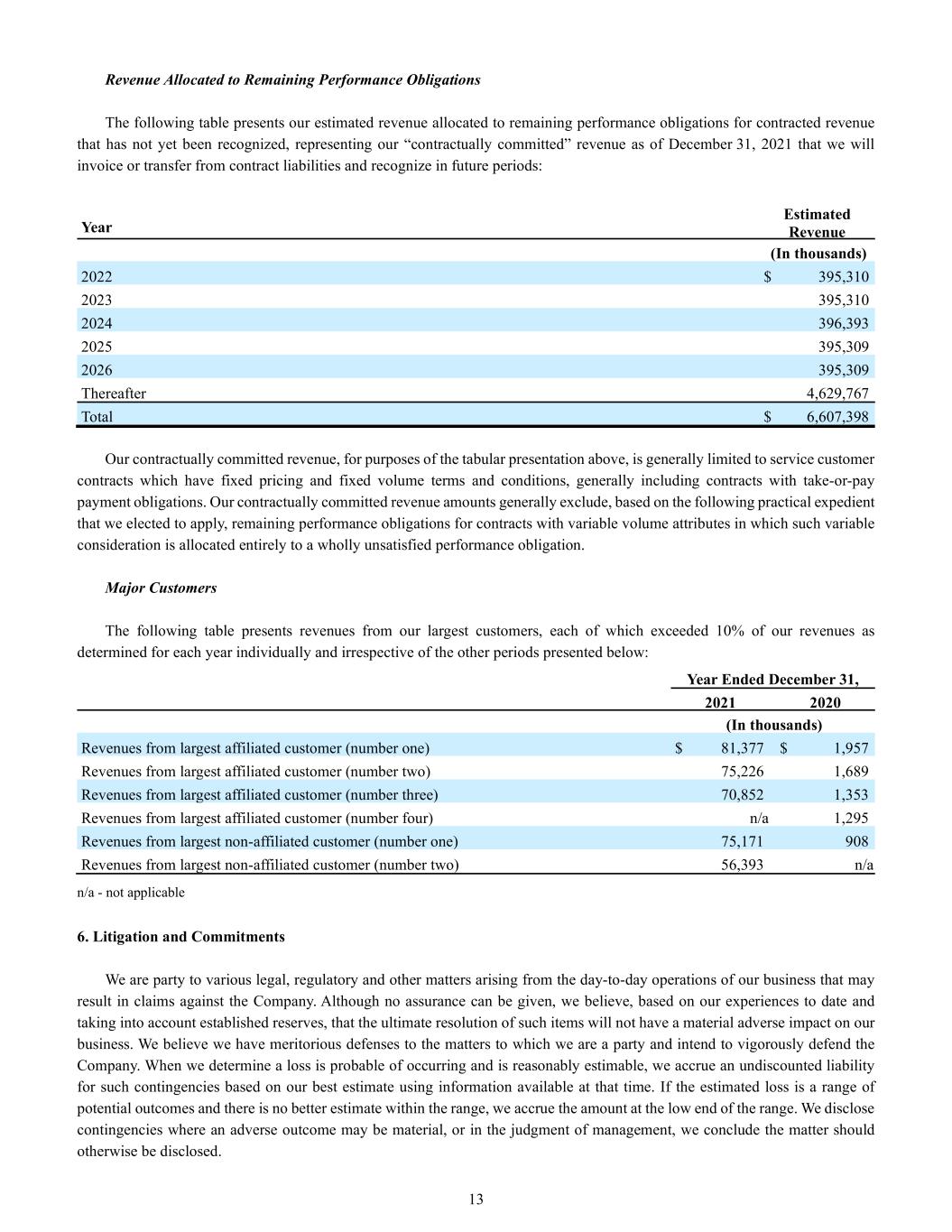
13 Revenue Allocated to Remaining Performance Obligations The following table presents our estimated revenue allocated to remaining performance obligations for contracted revenue that has not yet been recognized, representing our “contractually committed” revenue as of December 31, 2021 that we will invoice or transfer from contract liabilities and recognize in future periods: Year Estimated Revenue (In thousands) 2022 $ 395,310 2023 395,310 2024 396,393 2025 395,309 2026 395,309 Thereafter 4,629,767 Total $ 6,607,398 Our contractually committed revenue, for purposes of the tabular presentation above, is generally limited to service customer contracts which have fixed pricing and fixed volume terms and conditions, generally including contracts with take-or-pay payment obligations. Our contractually committed revenue amounts generally exclude, based on the following practical expedient that we elected to apply, remaining performance obligations for contracts with variable volume attributes in which such variable consideration is allocated entirely to a wholly unsatisfied performance obligation. Major Customers The following table presents revenues from our largest customers, each of which exceeded 10% of our revenues as determined for each year individually and irrespective of the other periods presented below: Year Ended December 31, 2021 2020 (In thousands) Revenues from largest affiliated customer (number one) $ 81,377 $ 1,957 Revenues from largest affiliated customer (number two) 75,226 1,689 Revenues from largest affiliated customer (number three) 70,852 1,353 Revenues from largest affiliated customer (number four) n/a 1,295 Revenues from largest non-affiliated customer (number one) 75,171 908 Revenues from largest non-affiliated customer (number two) 56,393 n/a n/a - not applicable 6. Litigation and Commitments We are party to various legal, regulatory and other matters arising from the day-to-day operations of our business that may result in claims against the Company. Although no assurance can be given, we believe, based on our experiences to date and taking into account established reserves, that the ultimate resolution of such items will not have a material adverse impact on our business. We believe we have meritorious defenses to the matters to which we are a party and intend to vigorously defend the Company. When we determine a loss is probable of occurring and is reasonably estimable, we accrue an undiscounted liability for such contingencies based on our best estimate using information available at that time. If the estimated loss is a range of potential outcomes and there is no better estimate within the range, we accrue the amount at the low end of the range. We disclose contingencies where an adverse outcome may be material, or in the judgment of management, we conclude the matter should otherwise be disclosed.
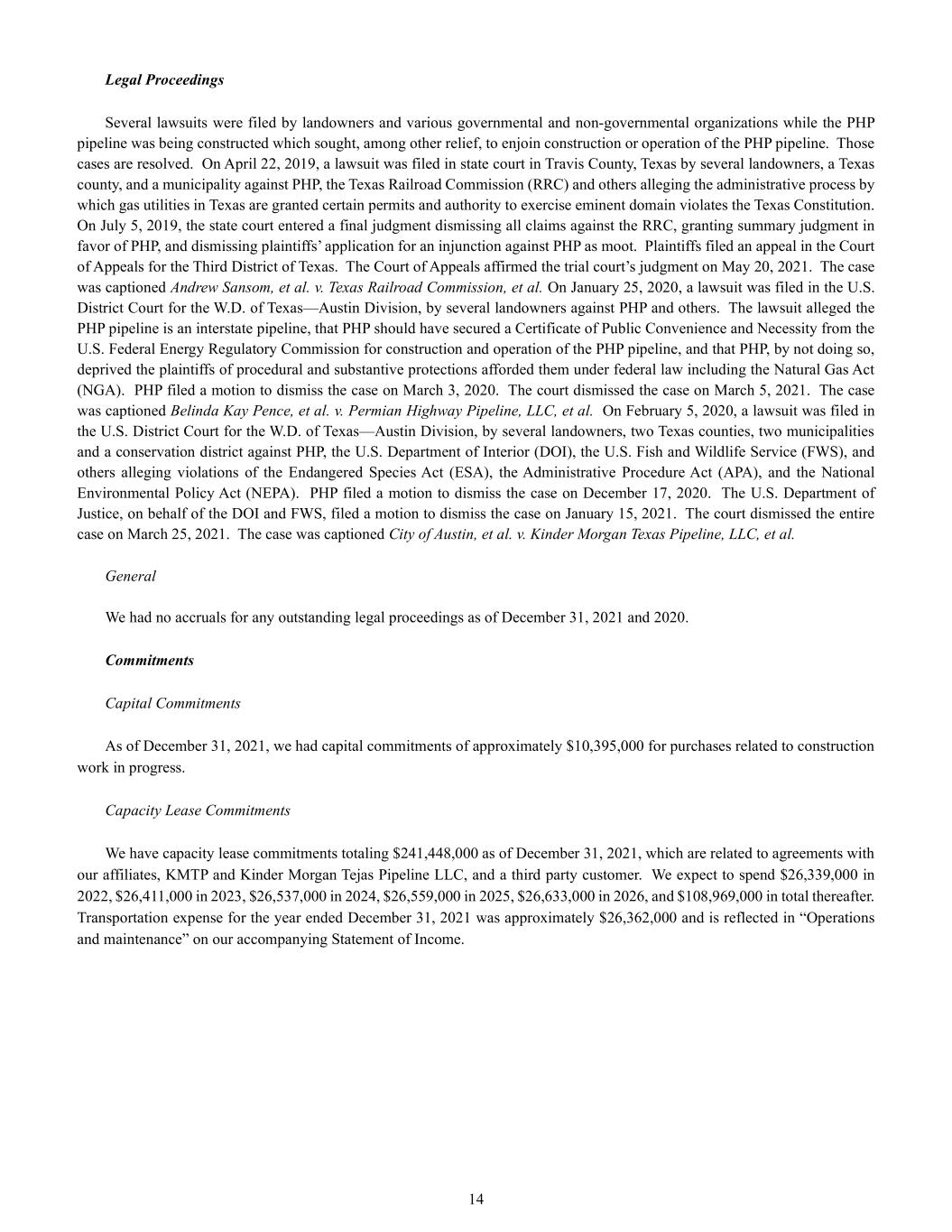
14 Legal Proceedings Several lawsuits were filed by landowners and various governmental and non-governmental organizations while the PHP pipeline was being constructed which sought, among other relief, to enjoin construction or operation of the PHP pipeline. Those cases are resolved. On April 22, 2019, a lawsuit was filed in state court in Travis County, Texas by several landowners, a Texas county, and a municipality against PHP, the Texas Railroad Commission (RRC) and others alleging the administrative process by which gas utilities in Texas are granted certain permits and authority to exercise eminent domain violates the Texas Constitution. On July 5, 2019, the state court entered a final judgment dismissing all claims against the RRC, granting summary judgment in favor of PHP, and dismissing plaintiffs’ application for an injunction against PHP as moot. Plaintiffs filed an appeal in the Court of Appeals for the Third District of Texas. The Court of Appeals affirmed the trial court’s judgment on May 20, 2021. The case was captioned Andrew Sansom, et al. v. Texas Railroad Commission, et al. On January 25, 2020, a lawsuit was filed in the U.S. District Court for the W.D. of Texas—Austin Division, by several landowners against PHP and others. The lawsuit alleged the PHP pipeline is an interstate pipeline, that PHP should have secured a Certificate of Public Convenience and Necessity from the U.S. Federal Energy Regulatory Commission for construction and operation of the PHP pipeline, and that PHP, by not doing so, deprived the plaintiffs of procedural and substantive protections afforded them under federal law including the Natural Gas Act (NGA). PHP filed a motion to dismiss the case on March 3, 2020. The court dismissed the case on March 5, 2021. The case was captioned Belinda Kay Pence, et al. v. Permian Highway Pipeline, LLC, et al. On February 5, 2020, a lawsuit was filed in the U.S. District Court for the W.D. of Texas—Austin Division, by several landowners, two Texas counties, two municipalities and a conservation district against PHP, the U.S. Department of Interior (DOI), the U.S. Fish and Wildlife Service (FWS), and others alleging violations of the Endangered Species Act (ESA), the Administrative Procedure Act (APA), and the National Environmental Policy Act (NEPA). PHP filed a motion to dismiss the case on December 17, 2020. The U.S. Department of Justice, on behalf of the DOI and FWS, filed a motion to dismiss the case on January 15, 2021. The court dismissed the entire case on March 25, 2021. The case was captioned City of Austin, et al. v. Kinder Morgan Texas Pipeline, LLC, et al. General We had no accruals for any outstanding legal proceedings as of December 31, 2021 and 2020. Commitments Capital Commitments As of December 31, 2021, we had capital commitments of approximately $10,395,000 for purchases related to construction work in progress. Capacity Lease Commitments We have capacity lease commitments totaling $241,448,000 as of December 31, 2021, which are related to agreements with our affiliates, KMTP and Kinder Morgan Tejas Pipeline LLC, and a third party customer. We expect to spend $26,339,000 in 2022, $26,411,000 in 2023, $26,537,000 in 2024, $26,559,000 in 2025, $26,633,000 in 2026, and $108,969,000 in total thereafter. Transportation expense for the year ended December 31, 2021 was approximately $26,362,000 and is reflected in “Operations and maintenance” on our accompanying Statement of Income.















